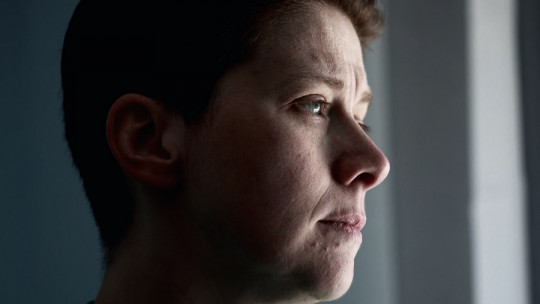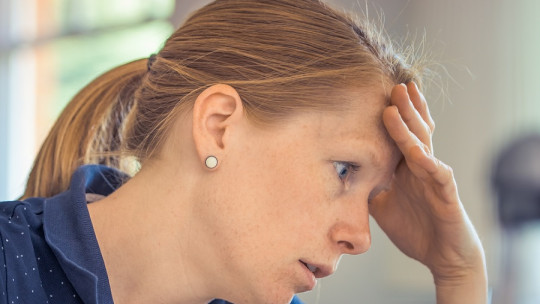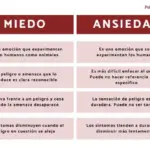
Anxiety is a normal and adaptive reaction that It is experienced in situations in which the individual feels threatened or in danger (real or imaginary). It can be understood as a defense mechanism that alerts the person that there is imminent danger, and prepares the individual physically and psychologically to face or flee from the threat. Thus, a certain degree of anxiety is even desirable for the normal handling of day-to-day demands. Only when the intensity is excessive and disproportionate to the threat does it become pathological.
In Anxiety Disorders there is usually no real triggering stimulus but rather it is the individual’s own mind that unconsciously evokes a thought or image that is threatening, causing the onset of the symptomatic picture of anxiety.
Furthermore, it is common to find testimonies from patients who state that these thoughts normally occur after a stressful event, just when the person was relaxed. Why is this happening?
What thoughts are related to Anxiety Disorders?
When the person is immersed in a situation that requires their full attention, most fears remain in the background, since the person hardly has time to think about anything. It is a question of priorities. However, when the stressful situation has passed and the person remains calm, it is normal for thoughts that have been temporarily avoided to reappear abruptly and unexpectedly
For Rodolfo De Porras De Abreu, psychologist and manager of Psychologists Málaga PsicoAbreu, anxiety is related to the feeling of “not being in control of your life.” People with anxiety often feel that they do not have control over their emotions, their body, their relationships, their work, their life. Taking charge is not about controlling everything, but about deciding what we want and what we don’t. It is common to find in anxiety therapies patients who have dedicated their lives to making those around them happy, but have forgotten about themselves. Hence the importance of thinking about yourself and decide what kind of life you want to live.
Related to this, cabinet psychologist Maribel Del Río states that anxiety can also be translated as an “excess of the future.” People with anxiety usually ask themselves the questions: What if…? They want to have everything under control they think that this way they will have no reason to worry, since they will have a solution already chosen for each ‘possible’ problem.
However… when does everything go according to plan? Never. Furthermore, the psychological cost of constantly asking ourselves possible problems to be prepared for means that we can never enjoy the present and feel that our mind is moving faster than our body.
What differentiates normal anxiety from pathological anxiety?
The characteristics of normal anxiety are as follows.
Below we will see an example:
In a robbery, the victim can feel his mind racing to decide the best way to ask for help, how to do it, whether he should attack the aggressor or simply flee. While on a psychological level the mind is calculating the different solutions, At a physical and behavioral level, the person prepares to face the problem Curiously, in these cases, the physical symptoms, despite being the same as in Anxiety Disorders, do not worry the person, since it is related and proportional to the external event.
On the other hand, the characteristics of pathological anxiety are the following.
An example of pathological anxiety could be the following:
In a public talk, some people feel dizziness, tachycardia, tremors, shortness of breath, tingling, a feeling of fainting or have thoughts such as getting stuck in the middle of the speech. In this particular case, there is no real danger, the intensity of the symptoms is excessive and the person can become blocked by their own fear, increasing their feeling of helplessness and strengthening the pathological circle. In these cases, the physical symptoms usually worry the person who suffers from them, because he feels that they are not proportional to the threat.
Symptoms of anxiety
Anxiety causes symptoms on a physical, psychological and behavioral level. The psychologists of the PsicoAbreu team affirm that physical symptoms are those that cause the greatest concern and psychological consultations. Among the most common are the feeling of shortness of breath, pressure in the chest or knot in the stomach, tachycardia, dizziness or feeling faint vomiting, loss or excess of appetite, cold sweats, tingling and numbness in some parts of the body, sleep problems, etc.
Among the most frequent psychological symptoms are the fear of losing control, fear of having a heart attack or dying from the symptoms, depersonalization, derealization, difficulties in attention, concentration and memory, and catastrophic thoughts.
Finally, in behavioral symptoms, people tend to avoid crowded places, go out alone, avoid certain situations, carry out checks to feel that everything is in order etc.
Types of Anxiety Disorders
The different forms that an Anxiety Disorder can take are the following.
1. Panic Disorder
It is a psychological disorder in which a person has episodes of intense fear that are accompanied by symptoms such as chest pain, a feeling of suffocation, tachycardia, dizziness, gastrointestinal problems, etc. They occur suddenly, lasting from a few minutes to a few hours. As a consequence of all this the person ends up developing a ‘fear of fear’ that is, fear of feeling the anguish generated during one of these crises again, which paradoxically can trigger a new anxiety crisis.
2. Agoraphobia
It has usually been related to the fear of being in open spaces. However, what the person really fears is having a panic attack and finding it difficult or embarrassing to escape from the place People who suffer from it usually avoid places such as shopping centers, public transportation, and in severe cases, the person may even be afraid to leave the house alone.
3. Generalized anxiety (GAD)
People with this disorder feel excessively worried about everything around them, whether important issues or not. They always put themselves in the worst and suffer constantly Although they are able to recognize that they worry too much, they cannot control it.
4. Specific phobias
The person feels an irrational and excessive fear of a stimulus, place or situation, so they end up avoiding them. The most common phobias are animals, darkness, blood, storms, heights, closed spaces, etc.
5. Social phobia
The person feels a intense and persistent fear of being judged negatively by other people or doing things that make you feel ashamed. Social phobia is often confused with shyness. However, the shy person is able to interact and participate in social events, while those who suffer from social phobia have such intense fear that they prevent them from participating in public in any way.
6. Obsessive Compulsive Disorder (OCD)
This disorder It is characterized by the performance of strange rituals or behaviors with the aim of calming anxiety arising from a premonitory thought. Obsessions refer to intrusive thoughts, ideas or images that cause worry and anxiety and that appear over and over again in the mind. Compulsions are actions taken to reduce the anxiety caused by obsessions.
7. Post-Traumatic Stress Disorder
In PTSD, the person experiences anxiety symptoms as a result of a psychological trauma such as the death of a family member, accident, theft, etc.
The treatment

The team of psychologists at the Psychologists Málaga PsicoAbreu Psychology offices is specialized in the effective psychological treatment of Anxiety Disorders. This therapy aims, on the one hand, to relieve anxiety symptoms and, on the other hand, to provide tools for the management and modification of emotional, thinking and behavioral factors that maintain high levels of anxiety and its consequences.








